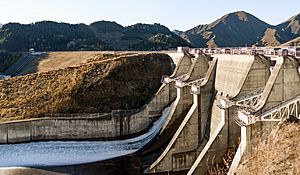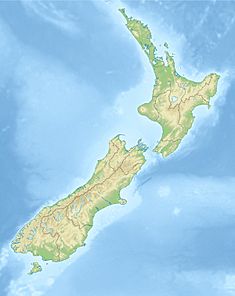Benmore Dam facts for kids
Quick facts for kids Benmore Dam |
|
|---|---|
 |
|
|
Location of Benmore Dam in New Zealand
|
|
| Location | Canterbury region, New Zealand |
| Coordinates | 44°33′50.92″S 170°11′49.92″E / 44.5641444°S 170.1972000°E |
| Construction cost | $62 million |
| Dam and spillways | |
| Type of dam | Earth-filled dam |
| Impounds | Waitaki River |
| Height | 110 m (360 ft) |
| Length | 823 m (2,700 ft) |
| Width (crest) | 10.6 m (35 ft) |
| Width (base) | 490 m (1,610 ft) |
| Dam volume | 28 million tonnes |
| Spillway capacity | 3,400 km3 (820 cu mi) |
| Reservoir | |
| Creates | Lake Benmore |
| Total capacity | 1.25 km3 (1,010,000 acre⋅ft) |
| Surface area | 75 km2 (29 sq mi) |
| Maximum water depth | 102 m (335 ft) |
| Power station | |
| Operator(s) | Meridian Energy |
| Commission date | 1965 |
| Hydraulic head | 92 m (302 ft) |
| Turbines | 6 x 93 MW (125,000 hp) |
| Installed capacity | 540 MW (720,000 hp) |
| Annual generation | 2,215 GWh (7,970 TJ) |
The Benmore Dam is the biggest dam in the Waitaki power system. It's located in the Canterbury area of New Zealand's South Island. This power system has eight other power stations.
Benmore Dam is New Zealand's largest earth-fill dam. It holds back a huge amount of water. The middle of the dam is made of special clay that doesn't let water through. This clay is supported by two massive sides made of river gravel.
The dam creates Lake Benmore, which holds 1.25 billion cubic metres of water. That's about 1.5 times the amount of water in Wellington Harbour. The dam also has a special overflow area called a spillway. This spillway can handle over 6,000 cubic metres of water every second. That's about 20 times the normal flow of the river!
Contents
Benmore Power Station: How It Makes Electricity
The Benmore Power Station is the second largest hydro station in New Zealand. Only the Manapouri station is bigger. Benmore is also the largest dam in the country. It can produce 540 megawatts (MW) of electricity.
Building the dam and power station cost $62 million. Work started in 1958. It began making electricity in 1965. New Zealand's Prime Minister, Sir Keith Holyoake, officially opened it on May 15, 1965. The New Zealand Electricity Department first owned it. Since 1999, Meridian Energy has owned and run the dam.
Between 2008 and 2010, the six giant turbines were updated. This cost $67 million. The upgrades mean the station uses 6% less water to make the same amount of power. This helps it create an extra 70 gigawatt-hours (GWh) of electricity each year. New control panels and other upgrades were also part of the plan.
Benmore is also important for sending electricity between New Zealand's islands. It's the southern end of the HVDC Inter-Island link. This link sends power from the South Island to the North Island. Special buildings at Benmore change the electricity from AC to DC. This allows it to travel 610 kilometres to the North Island.
Otematata: The Town Built for the Dam
Otematata is a small town that was created for the dam workers. It was built for them and their families. The Ministry of Works built the town. People called them "Uncle Mow" or "Big Mow." This was because the Ministry provided everything, even social activities. They even made sure criminals were not allowed in the town.
After the dam was finished, much of Otematata was taken apart. Many houses had been moved there from Roxborough. They were then moved again to the next dam project site in Twizel.
Today, Otematata still supports the dam. However, new technology means fewer people are needed to maintain it. Now, Otematata is a small holiday town. Only about 200 people live there permanently. The dam is about 8 kilometres up the valley from the town.
Benmore Dam: Quick Facts
- Lake Benmore size: About 75 square kilometres.
- Lake Benmore shoreline: 116 kilometres long.
- Dam top length: 823 metres.
- Dam top height: 100 metres.
- Dam width at base: 490 metres.
- Dam width at top: 10.6 metres.
- Dam material: 28 million tonnes of earth and rock.
- Water drop (Head): 92 metres. This is how far the water falls to spin the turbines.
- Average river flow: 340 cubic metres per second.
- Yearly power made: About 2,200 GWh.
- Total power capacity: 540 MW.
- Main machines: 6 large Francis turbines. These spin 6 generators to make power.
Electricity Transmission: Sending Power Around New Zealand
Benmore is a very important point in New Zealand's national electricity grid. It's one of two main places in the Waitaki Valley where electricity is switched. The other is the Twizel substation. Benmore is key because it's where the southern end of the HVDC Inter-Island link is located.
The main AC (alternating current) switching station is on the east side of the dam's tailrace (the water channel below the dam). Electricity made at Benmore Power Station goes into the national grid here. Three main 220 kilovolt (kV) power lines leave the Benmore station. They carry electricity to different places:
- A double-circuit line goes to the Twizel substation. One part goes through the Ohau C power station. The other goes through the Ohau B power station.
- A single-circuit line goes to the Islington substation in Christchurch. It passes through Twizel and Tekapo B power station.
- A double-circuit line goes to the Aviemore Dam.
The HVDC (high-voltage direct current) converter stations are on the west side of the tailrace. They connect to the AC switching station with lines that cross the tailrace. A new part called Pole 3 was added in 2013. It replaced an older part called Pole 1. Pole 3 helps send more power to the North Island.



